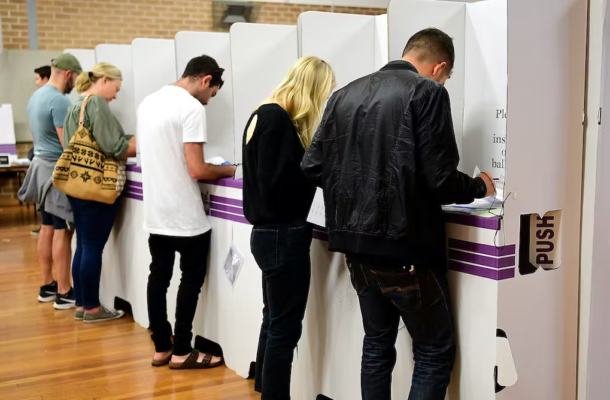Australia to vote on October 14

Australians will go to the polls on October 14 to vote in a referendum on an Aboriginal and Torres Strait Islander Voice. We have not voted in a federal referendum since 1999. So what do you need to know?
How is a referendum run?
A referendum is run by the Australian Electoral Commission in the same way as they do elections. That means most people will vote in a polling booth on Saturday October 14 at a local school or community centre. There will probably be a barbecue, with a democracy sausage or two, and a cake stall if you are lucky.
But there will also be pre-poll voting and postal voting, just like in an ordinary election. Voting in a referendum, like an election, is compulsory.
One difference will be that there will only be one ballot paper, and it will be short and easy to fill out. So the queues at polling booths should move quickly.
What is the referendum for?
A referendum is used to ask the Australian people whether they approve of a change being made to Commonwealth Constitution, which is Australia’s ultimate law.
In this case, the amendment doesn’t change existing words, but instead adds new words to the Constitution. If passed, the amendment would insert a new Chapter IX at the end of the Constitution, saying:
Chapter IX — Recognition of Aboriginal and Torres Strait Islander Peoples
129 Aboriginal and Torres Strait Islander Voice
In recognition of Aboriginal and Torres Strait Islander peoples as the First Peoples of Australia:
(i) there shall be a body, to be called the Aboriginal and Torres Strait Islander Voice;
(ii) the Aboriginal and Torres Strait Islander Voice may make representations to the Parliament and the Executive Government of the Commonwealth on matters relating to Aboriginal and Torres Strait Islander peoples;
(iii) the Parliament shall, subject to this Constitution, have power to make laws with respect to matters relating to the Aboriginal and Torres Strait Islander Voice, including its composition, functions, powers and procedures.
Despite the rather confusing public debate about other issues, all that voters are being asked to do in a referendum is decide whether or not the above words should be inserted in the Constitution.
Understanding the ballot
The ballot paper does not contain the words of the amendment you will be voting on, as in many cases the amendment would be far too long.
Instead, voters are asked to approve the amendment as set out in the proposed law that has been already passed by parliament. That proposed law is identified by its “long title’, which gives a brief description of its nature. In this case, voters will be asked:
A Proposed Law: to alter the Constitution to recognise the First Peoples of Australia by establishing an Aboriginal and Torres Strait Islander Voice.
Do you approve this proposed alteration?
A single box is then provided, and you fill in your ballot paper by either writing “yes” or “no” in that box.
While there are some “savings provisions” that allow votes in other forms to be counted if the voter’s intention is clear, it is best not to risk it. Just follow the directions and vote “yes” or “no” to ensure your vote counts.
If you want to see a copy of the amendment when you are voting, you could bring with you the pamphlet outlining the “yes” and “no” cases that the Australian Electoral Commission is currently sending to each household. It sets out the amendment and the arguments either way.
Giving an informed vote is important. The people who wrote the Constitution entrusted us with the final say about changes to Australia’s most important law, in the expectation that we would perform our constitutional duty responsibly. We shouldn’t betray that trust.
When will we know the result?
All the votes given in polling booths will be counted by hand on the night, so the results should come in pretty quickly, as it is a single ballot paper with a simple “yes” or “no” choice. Pre-poll votes and those postal votes that have already been received will also be counted on the night.
That means we should get a good idea of the result on the night, but if it is very close, we would have to wait some days until the rest of the postal votes arrive and are counted.
All votes go through two counts to double-check results and the counting process can be watched by scrutineers.
Unlike an election, there is a special double majority that has to be met for a referendum to pass.
First, a majority of formal votes across the country (including in the territories) would need to be “yes” votes.
Second, there would have to be a majority of “yes” votes in at least four out of six states (for which territory votes do not count). This means, for example, that 60% of voters in the country could vote “yes”, but the referendum could still fail if a majority of voters in three of the less populous states voted “no”.
What happens if the referendum passes or fails?
If the referendum passes, it is then sent to the governor-general, who gives assent to it. Once that happens, the amendment to the Constitution is made.
The amendment says “there shall be a body, to be called the Aboriginal and Torres Strait Islander Voice”. But it also says legislation is needed to determine the composition of the Voice and how it operates. The next step would be consultation about such matters before legislation is enacted to give effect to the Voice.
If the referendum fails, no change to the Constitution is made.
This article was published by The Conversation.
Anne Twomey is a Professor of Constitutional Law at the University of Sydney. Her research interests include constitutional history, parliamentary procedure and practice and the Monarchy.













